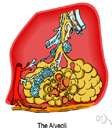air sac
(redirected from Air sacs)Also found in: Thesaurus, Medical, Encyclopedia.
air sac
n.
1. An air-filled space in the body of a bird that forms a connection between the lungs and bone cavities and aids in breathing and temperature regulation.
2. See alveolus.
3. A saclike, thin-walled enlargement in the trachea of an insect.
4. An inflatable pouch attached to the larynx in certain mammals, including the nonhuman great apes.
American Heritage® Dictionary of the English Language, Fifth Edition. Copyright © 2016 by Houghton Mifflin Harcourt Publishing Company. Published by Houghton Mifflin Harcourt Publishing Company. All rights reserved.
air sac
n
1. (Zoology) any of the membranous air-filled extensions of the lungs of birds, which increase the efficiency of gaseous exchange in the lungs
2. (Zoology) any of the thin-walled extensions of the tracheae of insects having a similar function
Collins English Dictionary – Complete and Unabridged, 12th Edition 2014 © HarperCollins Publishers 1991, 1994, 1998, 2000, 2003, 2006, 2007, 2009, 2011, 2014
air′ sac`
n.
2. any of certain cavities in a bird's body connected with the lungs.
[1820–30]
Random House Kernerman Webster's College Dictionary, © 2010 K Dictionaries Ltd. Copyright 2005, 1997, 1991 by Random House, Inc. All rights reserved.
air sac
1. An air-filled space in the body of a bird that forms a connection between the lungs and bone cavities. See alveolus.
2. A sac-like enlargement in the trachea of an insect.
3. A bag-like piece of skin or tissue below the jaw of certain animals, such as the bullfrog and orangutan, that can be inflated to increase sound production.
The American Heritage® Student Science Dictionary, Second Edition. Copyright © 2014 by Houghton Mifflin Harcourt Publishing Company. Published by Houghton Mifflin Harcourt Publishing Company. All rights reserved.
ThesaurusAntonymsRelated WordsSynonymsLegend:
Switch to new thesaurus
| Noun | 1. |  air sac - a tiny sac for holding air in the lungs; formed by the terminal dilation of tiny air passageways air sac - a tiny sac for holding air in the lungs; formed by the terminal dilation of tiny air passagewayslung - either of two saclike respiratory organs in the chest of vertebrates; serves to remove carbon dioxide and provide oxygen to the blood sac - a structure resembling a bag in an animal |
| 2. | air sac - any of the thin-walled extensions of the tracheae of insects insect - small air-breathing arthropod sac - a structure resembling a bag in an animal | |
| 3. | air sac - any of the membranous air-filled extensions of the lungs of birds bird - warm-blooded egg-laying vertebrates characterized by feathers and forelimbs modified as wings sac - a structure resembling a bag in an animal |
Based on WordNet 3.0, Farlex clipart collection. © 2003-2012 Princeton University, Farlex Inc.